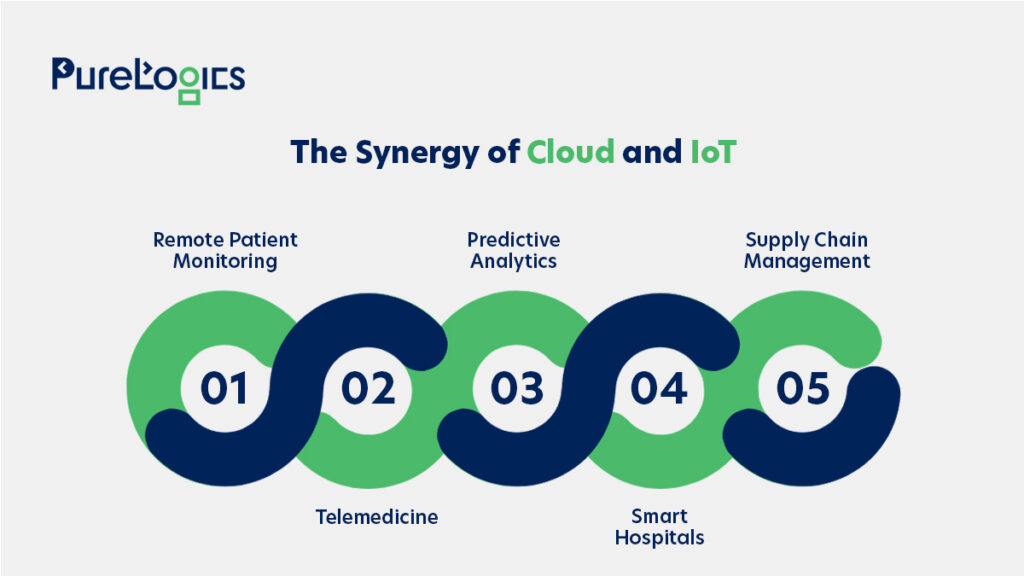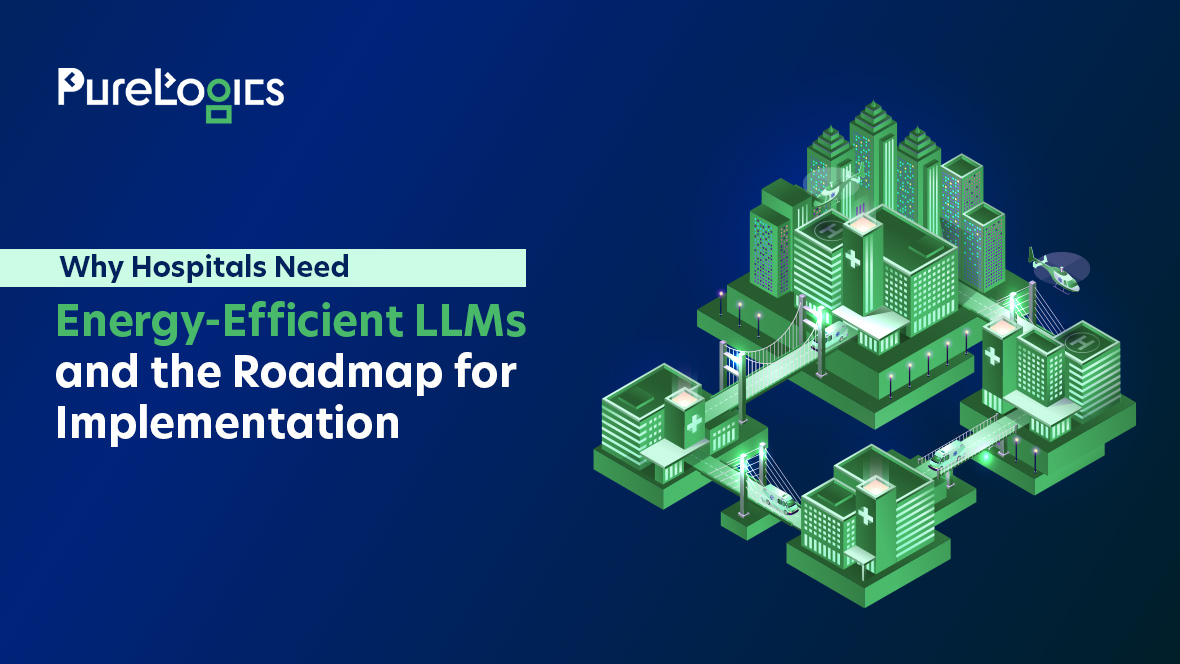The convergence of cloud computing and the Internet of Things (IoT) is revolutionizing the healthcare sector. The integration has paved the way for advanced smart e-healthcare solutions. It is not just enhancing operational efficiencies but also transforming patient care, data management, and overall healthcare delivery.
This blog post explores the potential of cloud and IoT integration in creating innovative e-healthcare solutions, their benefits, challenges, and future prospects. However, before we dive into details, let’s have a brief understanding of cloud computing and IoT in healthcare!
Understanding Cloud Computing in Healthcare
Cloud computing allows for storing, managing, and processing data over the internet rather than on local servers or personal computers. This paradigm shift enables healthcare organizations to access vast amounts of data in real time, facilitating better decision-making and improved patient outcomes. The following are three essentials features of cloud computing in healthcare:
Scalability: Healthcare providers can easily scale their IT resources according to demand, especially during crises like pandemics.
Cost-effectiveness: Reduces the need for significant upfront infrastructure investment, allowing institutions to allocate resources more efficiently.
Interoperability: Different healthcare systems can communicate seamlessly, allowing for integrated care pathways.
Understanding IoT in Healthcare
IoT refers to the network of interconnected devices that communicate and share data with each other. In healthcare, IoT devices range from wearables (like smartwatches) that monitor patient vitals to smart beds that track patient movement. The main benefits of IoT in healthcare include:
Real-time Monitoring: Continuous tracking of patient health metrics, leading to timely interventions.
Data Collection: Accumulation of vast amounts of data for analytics, enhancing predictive and preventive care.
Enhanced Patient Engagement: Patients can actively participate in their care through connected devices.
Synergy of Cloud and IoT
When cloud computing and IoT are integrated, the resulting smart e-healthcare solutions leverage the strengths of both technologies. This synergy enables healthcare providers to deliver more personalized, efficient, and cost-effective care. Below are several key areas where this integration is making a significant impact:

1. Remote Patient Monitoring
Cloud and IoT technologies facilitate remote patient monitoring (RPM), allowing healthcare professionals to track patients’ health metrics from anywhere. Wearable devices collect data such as heart rate, blood pressure, and glucose levels, which are then transmitted to cloud-based platforms. Healthcare providers can analyze this data in real-time, making timely decisions and providing interventions when necessary.
Example: A diabetic patient wearing a continuous glucose monitor can have their glucose levels automatically uploaded to a cloud platform, where their healthcare provider can monitor trends and adjust treatment protocols accordingly.
2. Telemedicine
The integration of cloud computing with IoT supports the expansion of telemedicine, enabling healthcare providers to offer consultations and follow-ups remotely. IoT devices enhance these consultations by providing live data from patients, allowing for informed decision-making during virtual visits.
Benefits: Telemedicine improves accessibility for patients in rural areas, reduces healthcare costs by cutting travel and facility expenses, and enhances patient satisfaction by offering convenient, remote consultations.
3. Predictive Analytics
The massive amount of data generated by IoT devices can be harnessed for predictive analytics in cloud environments. Machine learning algorithms can analyze patterns and predict health issues before they escalate, leading to proactive care.
Application: Hospitals can analyze data from wearable devices to identify patients at risk of falls, allowing for timely interventions and preventative measures.
Smarter Care with Cloud and IoT
Identify health risks early with advanced analytics.
4. Smart Hospitals
Cloud and IoT integration can lead to the development of smart hospitals, where various systems and devices are interconnected. From smart beds that monitor patient movements to automated medication dispensing systems, smart hospitals enhance operational efficiency and patient safety.
Example: IoT sensors can monitor bed occupancy and adjust environmental controls automatically, improving patient comfort and conserving energy.
5. Supply Chain Management
Efficient supply chain management is critical in healthcare. IoT devices can track inventory levels in real-time, while cloud computing offers a platform for data analysis and forecasting. This integration minimizes waste, optimizes stock levels, and ensures that essential medical supplies are always available.
Benefits of Cloud and IoT Integration in E-Healthcare
Now, let’s have a look at the benefits of cloud and IoT integration in e-healthcare!
| Benefit | Description |
| Improved Patient Outcomes | Real-time monitoring leads to better outcomes and fewer complications. |
| Enhanced Data Security | Strong security measures protect patient data and ensure regulatory compliance. |
| Cost Reduction | Streamlined operations result in significant cost savings and fewer emergency visits. |
| Increased Operational Efficiency | Automation and cloud management boost efficiency, allowing more focus on patient care. |
Challenges of Integration
Despite the many benefits, several challenges exist in integrating cloud and IoT technologies in healthcare:
Data Privacy Concerns: As patient data is increasingly stored in the cloud, concerns about data privacy and breaches become paramount. It is essential for healthcare organizations to establish strong security protocols to safeguard confidential information.
Interoperability Issues: Different healthcare systems may use varying standards and protocols, making it challenging to achieve seamless integration. Standardizing protocols across systems is crucial for effective data sharing.
Technical Barriers: Implementing advanced technologies may require significant training and adaptation, particularly for staff who may not be technologically savvy. Organizations must invest in training and support to facilitate this transition.
Secure and Efficient E-Healthcare Systems
Address privacy, interoperability, and technical barriers with expert-driven strategies.
Future of Cloud and IoT in E-Healthcare
The future of e-healthcare lies in the continued evolution of cloud and IoT technologies. Innovations such as artificial intelligence (AI), machine learning, and blockchain are set to further enhance healthcare delivery. AI algorithms can provide deeper insights from data collected via IoT devices, while blockchain can secure patient records and ensure data integrity.
As the healthcare landscape continues to evolve, the integration of cloud and IoT will undoubtedly play a pivotal role in shaping smart e-healthcare solutions that prioritize patient care, operational efficiency, and cost-effectiveness.
At PureLogics, we specialize in creating tailored cloud and IoT solutions that empower healthcare organizations to enhance patient care, streamline operations, and drive innovation. Our expert team is dedicated to transforming your healthcare services into smart, data-driven experiences that improve outcomes and reduce costs.
Contact PureLogics now, and let’s revolutionize your e-healthcare journey together!


 [tta_listen_btn]
[tta_listen_btn]
 December 20 2024
December 20 2024






